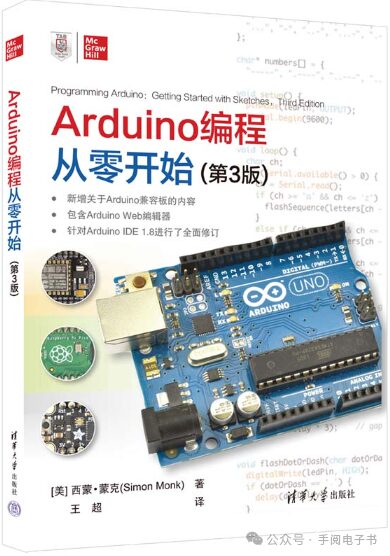
Editorial Recommendation
A new Arduino programming guide that requires no prior programming experience! This edition has been comprehensively updated to introduce how to quickly and easily write all programs based on Arduino models using a modified C language and the Arduino IDE. Electronics master Simon Monk guides you through all concepts with simple language and clear instructions. The book provides dozens of easy-to-follow examples and high-quality illustrations, and all sketch example programs are ready to use and can be modified as needed. The book also introduces all new knowledge for writing programs for other mainstream development boards using the Arduino framework.
Content Includes:
● Configuring Arduino and starting to write sketch programs● Understanding the basics of C language and Arduino IDE● Adding functions, arrays, and strings to sketch programs● Setting up digital and analog I/O on Arduino● Using Arduino-compatible boards, including ESP32, Pico, and micro:bit● Using built-in and custom Arduino libraries● Writing sketch programs to store data in EPROM or flash memory● Implementing interfaces with various displays (including LCD)● Connecting to the Internet and configuring Arduino as a web server● Developing interesting and practical IoT programs
Content Summary
A new Arduino programming guide that requires no prior programming experience! This edition has been comprehensively updated to introduce how to quickly and easily write all programs based on Arduino models using a modified C language and the Arduino IDE. Electronics master Simon Monk guides you through all concepts with simple language and clear instructions. The book provides dozens of easy-to-follow examples and high-quality illustrations, and all sketch example programs are ready to use and can be modified as needed. The book also introduces all new knowledge for writing programs for other mainstream development boards using the Arduino framework.
Content Includes:
● Configuring Arduino and starting to write sketch programs● Understanding the basics of C language and Arduino IDE● Adding functions, arrays, and strings to sketch programs● Setting up digital and analog I/O on Arduino● Using Arduino-compatible boards, including ESP32, Pico, and micro:bit● Using built-in and custom Arduino libraries● Writing sketch programs to store data in EPROM or flash memory● Implementing interfaces with various displays (including LCD)● Connecting to the Internet and configuring Arduino as a web server● Developing interesting and practical IoT programs
Author Biography
Dr. Simon Monk holds a Bachelor’s degree in Cybernetics and Computer Science and a PhD in Software Engineering. He has been an active electronics enthusiast since childhood. Today, he is an accomplished author with unique insights and perspectives on Arduino and Raspberry Pi. Dr. Monk has written over 20 books on maker and electronics topics, including bestsellers like Programming Arduino, 30 Arduino Projects for the Evil Genius, Hacking Electronics, and Make Your Own PCBs with Fritzing. He also designs products for MonkMakes Ltd.
Table of Contents
Chapter 1: Introduction to Arduino 11.1 Microcontrollers 11.2 Exploring the Arduino Uno Development Board 31.2.1 Power Interface 31.2.2 Supply Interface 41.2.3 Analog Input Interface 41.2.4 Digital Interface 41.2.5 Microcontroller 51.2.6 Other Components 51.3 WiFi-Supported Arduino-Compatible Boards 61.4 The Origins of Arduino 71.5 Powering Up 81.6 Installing Software 81.7 Uploading Your First Sketch Program 10
Show All Information
Foreword
When it comes to creating microcontroller-based projects, Arduino interface development boards provide a low-cost, user-friendly technology. With minimal electronics knowledge, you can make Arduino control everything from stage lighting to managing solar power systems.There are many project-based books that will show you how to connect devices to Arduino, including the author’s own 30 Arduino Projects for the Evil Genius. However, this book focuses on how to use the Arduino IDE to write programs for Arduino and Arduino-compatible boards.This book will explain how to make Arduino programming simple and fun, avoiding the tricky code that often hinders projects. Guided by this book, you will start with the most basic C language used in Arduino and gradually understand the Arduino programming process.0.1 What is Arduino?Arduino refers to the hardware and software environment for programming microcontroller boards. Because microcontroller boards come in various shapes and sizes, the standard development board will choose the most popular official Arduino board, the Arduino Uno.

Customer Service WeChat Pre-sales Consultation After-sales Service